Grand Prix 4 Preview
Geoff Crammond's next F1 game is almost finished. Check out our in-depth preview for all the details on the upcoming racer.
It was nearly 10 years ago that Britain-based software designer and programmer Geoff Crammond and his small band of associates completed work on one of the first true racing simulations ever to appear on the computer, the groundbreaking World Circuit. Like Papyrus Design Group's IndyCar Racing, also released in 1993, World Circuit flirted with authenticity and helped establish virtual racing as something other than a joystick-bashing action-fest developed primarily for the kiddies. The PC has since seen a variety of quasi-realistic racing games from a variety of sources, each of which has attempted to re-create the experience of driving a real-life car. Yet it was Crammond and David Kaemmer's Papyrus that ultimately got the ball rolling with two titles that have since served as the inspiration for all other "realistic" racing games that have followed.
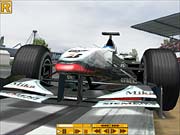
But while Papyrus has since taken on a variety of racing disciplines with award-winning games such as Grand Prix Legends and the acclaimed NASCAR Racing series, Crammond has instead kept a tightly knit group and remained focused on the world of modern-day Formula 1. In 1996 came the worthy successor to World Circuit, Grand Prix II, at a time when most every other Formula 1-styled game (Domark's Formula 1, for example) was little more than a coin-op refugee. Grand Prix II pushed the realism envelope once again and introduced such concepts as textured SVGA graphics and sentient software-controlled competition. Revered even today as a landmark open-wheeled sim, Grand Prix II was beautiful to behold even when you were hurtling through the air after a head-on collision.
It would be four more years before Crammond and Hasbro (having enveloped original publisher MicroProse) would release the third installment in the series, Grand Prix 3. Still a strong game but ultimately not the quantum leap forward many had expected, Grand Prix 3 arrived in the midst of a sudden and unexpected glut of quality F1 simulations. Titles such as Ubi Soft's superb F1 Racing Sim and Electronic Arts' flawed but promising F1 2000 had emerged from out of the blue to challenge Grand Prix II for leadership of the virtual F1 world. Though it now sported unprecedented dynamic weather effects and several welcome tweaks, Grand Prix simply wasn't the automatic lock it once was.
Now, Crammond and his newly organized Simergy design team are preparing to debut their next-generation racing game in a North American market that has just witnessed the release of Grand Prix's most worthy F1 challenger to date, EA's effectively convincing F1 2002. Scheduled to be published by Infogrames this September, the latest in the Grand Prix series concerns itself with the 2001 Formula 1 season and promises upgrades all around. We had a chance to take a nearly finalized prerelease version of the game for a spin.
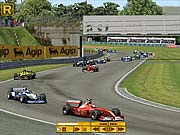
Like its immediate predecessor, Grand Prix 4 looks to be evolutionary rather than revolutionary. It won't sport wholly revamped physics modeling or any truly incredible innovations, and it quite probably will not put a dagger through the heart of its strongest rival. It will be, however, a considerably more impressive game than Grand Prix 3 was, in both a visual and audible sense. It will feature numerous new perks and refinements and certainly should be of significant interest to any serious open-wheeled enthusiast and, in particular, fans of the venerated Crammond style.
As an official product of the 2001 FIA Formula 1 World Championship, Grand Prix 4 will not examine the current season, but instead the events and teams of 2001. All drivers that participated in the final race of the season are included, as are all 17 circuits (Melbourne, Sepang, Interlagos, Imola, Barcelona, A1-Ring, Monte Carlo, Montreal, Nurburgring, Magny-Cours, Silverstone, Hockenheim, Hungaroring, Spa-Francorchamps, Monza, Indianapolis, and Suzuka). Purists should note that the game authentically exhibits the high-speed 2001 edition of Hockenheim rather than the altered and considerably more technical version constructed for 2002 and included in EA's F1 2002.
Behind the Wheel
What you may first notice when you install Grand Prix 4 is its size. As opposed to the 300MB usurped by the previous incarnation, a full install of the latest version will gobble up nearly 800MB. Much of this increase can be attributed to the game's new Grand Prixaedia module, a cyber reference guide to many of the most important facets of real-life and virtual F1 racing and preparation. Capably hosted by Arrow's team member Mark Hemsworth and conveniently accessible from within the program, Grand Prixaedia will merge full-motion audio-video snippets and text-based descriptions and instructions into a neat package that will undoubtedly assist those who want to make the jump from merely driving a car to knowing what makes it tick. One of Grand Prixaedia's most intriguing sections is its "Tour of a Formula 1 Car," where you'll get a chance to see exactly what all those adjustable components really look like and where they are positioned.
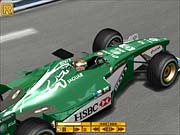
Series veterans will be immediately struck by the game's retooled presentation. As opposed to the colorful, vibrant, and sometimes cartoonish interfaces of years past, Grand Prix 4 sports blackened menu screens and filtered blue-tone animations. It'll be a dramatic new look that may just as easily be seen as stylish or morose. In any case, the revamped menu structure will be only marginally easier to use than before. You will still be compelled to wade through lots of screens to do the things you have to do.
Fortunately, there is some validation for all those complex menus. Following in the footsteps of its predecessors, Grand Prix 4 will remain one of the most adaptable and option-packed racing games on the market. Newcomers especially will appreciate its massive roster of driving aids, which include such familiar assists as automatic brakes, automatic gears, automatic spin realignment, indestructibility, onscreen gear suggestions, steering help, and an option to superimpose the ideal racing line on the track in front of you. For the 2002 model, Crammond and company have replaced throttle help with traction control and have added a new aid, launch control, to help drivers decrease wheel spin when accelerating from a standstill.
As in the past, you will be able to select from five difficulty settings, each of which presents varying levels of opponent skill and speed. We found that the least challenging of these, rookie mode, will allow a talented driver starting from the back of the pack to stay in touch with the leaders and potentially win a given event, even in an unmodified car. In its most challenging mode, ace, the gap between the front of the pack and the back becomes far more pronounced, and the overall speed is suitably higher.
Still, the ace mode of Grand Prix 4 won't seem quite as impossibly fast as the ace mode of Grand Prix 3. The developers have either moderated the AI speed or provided us human drivers with a slightly superior stock machine, but certainly a skilled player should now be able to keep pace with the backmarkers. Moving up in the ace ranks will, as always, involve judicious adjustments in the game's typically large and very complex garage facility, a thorough and exacting knowledge of every track turn and straightaway, and avoidance of the game's unforgiving black-flag penalties. In Grand Prix 4, black flags automatically retard your speed for several seconds and are doled out routinely, even when you've cut just a few feet from a corner.
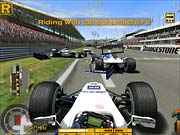
For the first time, Crammond has incorporated real-world GPS data into Grand Prix's environmental rendering, thus making the game and its circuits more authentic than ever. Whether you'll notice the difference between the renderings of prior models and this year's edition will depend on how familiar you are with a given circuit, but the general visual impression is certainly beautiful. Aside from actual track geometry, Grand Prix 4 venues are chock-full of genuine scenery elements. At Silverstone, for instance, you'll find vintage aircraft littering the nearby countryside--a nod to that location's status as a former airfield. Monaco is now absolutely loaded with buildings, structures, statues, and gorgeous scenery. And no matter where you're racing, the grandstands are populated with animated spectators waving flags, popping flashbulbs, and generally mimicking the actions of a real crowd.
In fact, most every graphical element has been enhanced. Simergy has incorporated full-screen antialiasing to smooth out the comparatively rough object outlines of previous editions. It has reproduced the actual car shapes and decaling from the 2001 season and introduced support for hardware transform and lighting to help make the images seem less washed out and more realistic. In the pit area, a fully staffed motion-captured pit crew will hustle out and scramble over your car--a very impressive routine that can only be appreciated by witnessing it firsthand. Indeed, every Grand Prix 4 team sports a fully stocked and fully animated pit staff running about hither and thither to jack cars up, drop them down, refuel and retool them, and push them back into their respective garages.
Crashing Cars, Stable System
On the track, you will be able to choose to monitor activities not just from the cockpit, but also with the aid of an optional top-down map of the nearby vicinity. You may also turn your head virtually from side to side, watch the action through the restrictive confines of a helmet visor, and zoom the cockpit perspective forward and backward for a better view of the peripheral frivolities. Of course, Grand Prix 4 continues to offer changeable dynamic weather, a splendid bit of realism introduced in Grand Prix 3 and relatively poorly duplicated in EA's F1 2002.
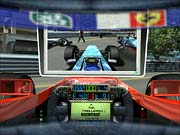
However, depending on your personal preferences, you may find the Grand Prix 4 driving experience to be somewhat sedate when compared with its flashy new EA counterpart. For starters, the game simply doesn't feel as fast. In F1 2002, you can see your car bounce and jiggle over each bump and rut, whereas Grand Prix 4 cars seem relatively unaffected by pavement blemishes. Nor does Grand Prix 4 deliver the same level of track surface detail, thereby giving you fewer immediate visual reference points from which to judge your speed. And in the untimely event of a collision, the generally impressive game audio engine doesn't seem to convey the drama of such an incident. Thankfully, Simergy has enhanced the physics and graphics routine of a crash so that various car body parts detach and bounce about, often colliding again with your car as you try to extricate yourself.
Yet the game may run to its full graphics potential only on the most powerful computing setups. If our prerelease forays are any indication, jumpy frame rates will be an issue for anyone not running at least the recommended system requirements. On both our test computers, a P4 with a GeForce3 video card and an Athlon 1600+ with a state-of-the-art GeForce4 Ti 4600, we achieved a truly fluid frame rate only by reducing or deactivating certain effects or by running at 800x600 resolution.
From a vehicular physics standpoint, Grand Prix 4 will provide only a marginally different driving experience than its already amazing predecessor. The biggest issue for some hard-core racers may well be its lack of danger. Unlike an F1 2002 car, a Grand Prix 4 vehicle feels a bit pendulous, pivoting at its middle point and exuding little of that EA seat-of-your-pants feel. It conforms to the track more than it runs over the top of it, breaking away only in extremely stressful situations and then doing so quite aggressively. In comparison to driving an F1 2002 car, you quite probably won't feel the same level of edge-of-the-envelope car control or the same quality of powerslides and four-wheel drifts.
You will, nevertheless, deal with some of the best artificially intelligent opposition in the racing business. Grand Prix 4 AI drivers move around the track with a humanlike awareness. They enact quick but plausible avoidance maneuvers when their living, breathing peer behaves erratically. However, they will not engage in as much contact with each other as their F1 2002 counterparts. Whether this is a good thing depends on your predilection for carnage.
Simergy has clearly dedicated a good deal of effort to enhancing in-car acoustics. Unlike Grand Prix 3, Grand Prix 4 will feature actual F1 engine samples and audible competitor vehicles. The effect is stunning, particularly at the outset of an event when you'll hear all 22 cars harmoniously revving. That those revs are completely analog and plagued with none of the digital "stepping" of the EA series only adds to the sensation. The game also supports four-speaker output and EAX effects to help immerse you in the midst of a true surround sound cacophony, though a fully activated roster of audio enhancements will negatively impact the already fragile frame rate.
As always, Grand Prix will feature a variety of exclusive and semi-exclusive perks. Hot seat mode, for example, wherein two drivers compete in turn-based form on one computer, remains a Crammond staple. The game also allows you to jump from car to car during any racing session, shift with an optional manual clutch, and keep aware of current developments merely by watching the displays on your oh-so-informative steering wheel. As an added bonus, we were able to Alt-Tab between Grand Prix 4 and other applications without so much as a single performance hiccup. The game does not, unfortunately, offer a parade lap or an instant race restart function--two holdover quirks from prior editions.
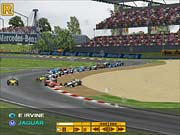
As has been typical for the series, the game will offer bazillions of onboard and external camera positions from which to observe and replay your race. And now, it finally lets you save and access replays of longer than 30 seconds. In fact, a Grand Prix 4 replay may stretch to an hour or more, as long as you have the hard drive space to handle it. Veteran Grand Prix drivers will also appreciate the rain droplets that form on exterior camera lenses during wet races.
There's no arguing that Geoff Crammond's Formula 1 games are a force to be reckoned with on the PC. And certainly his latest effort looks to be another worthy game for open-wheeled racers worldwide. We'll all get a chance to sample his latest marvel when it comes to a computer near you in mid-September.
Got a news tip or want to contact us directly? Email news@gamespot.com
Join the conversation